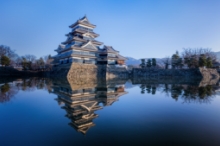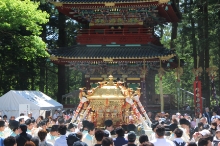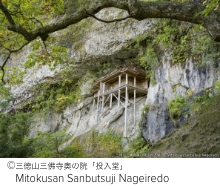
Japan is a country steeped in well preserved history and culture. In addition to the many UNESCO World Heritage Sites throughout the country, there are also countless national treasures including castles, shrines, temples, archeological sites, and important cultural heritage pieces. While it may be impossible to see each and every national treasure Japan has to offer in a single trip, here are just a few of the important, must-see, and even lesser known of Japan’s many stunning national treasures.
Castles
Of the 12 original castles remaining in Japan, only 5 castles have their main keeps designated as national treasures. Matsumoto Castle in Nagano is one such castle and its five-story castle tower is reportedly the oldest remaining original, dating back to the 16th century. In addition to the quaintness of the swans swimming in the castle moat and the hundreds of cherry trees that bloom in the gardens in spring, the castle grounds are patrolled by costumed ninja and samurai that entertain and educate about the history of the castle and those who lived in it. Easily accessible from Tokyo by bullet train, it is a must-see when traveling through central Japan. Just north of Kyoto in Shiga prefecture lies the stately Hikone Castle, perhaps the best-preserved castle in the nation which has stood almost entirely unchanged for 400 years. In addition to the stunning views of Lake Biwa, Japan’s largest fresh-water lake, and multitude of cherry trees on property, nearby Genkyuen garden offers a picturesque strolling garden and teahouse where one can enjoy some matcha and Japanese sweets.
Perhaps the grandest castle in Japan, Himeji Castle is lovingly referred to as the White Heron Castle for its beautiful white washed walls and stately appearance. With over 600 years of history, an impressive 7-story castle keep, and over 1,000 cherry trees on property, it is no wonder that this beloved national treasure was also one of the first ever sites in Japan to receive a UNESCO World Heritage Site designation in 1993. Visitors can prolong their walk back in time by visiting the lovely and labyrinthian Kokoen Garden next door which also features a tea house for experiencing a traditional tea ceremony as well as a restaurant serving delectable lunches in traditional lacquerware boxes.
Shrines
Located a mere 90-minutes from Tokyo, Nikko Toshogu Shrine is surrounded by pristine nature and hosts many important historical and cultural national treasures. Aside from enshrining one of Japan’s most famous Shogun, Tokugawa Ieyasu, this UNESCO World Heritage Site also features the original carving of the Three Wise Monkeys that inspired the famous proverb, “see no evil, speak no evil, hear no evil.” This is but one of many splendid and intricate carvings for which Nikko Toshogu Shrine is renowned. Nara is home to many sacred and historically significant shrines and temples but perhaps one of the grandest shrines is Kasuga Taisha Shrine. Built more than 1,200 years ago, this sacred shrine is known for its bright vermillion paint and many, many lanterns. More than 2,000 stone lanterns guard the path to the main building and another more than 1,000 bronze lanterns adorn the main hall. The architecture of this shrine is so iconic that it has been categorized as its very own style. A final must-see shrine when visiting Japan is the equally iconic and even more scenic Itsukushima Shrine on Miyajima Island. Many will know this important cultural property for the emblematic floating torii gate that welcomes visitors to the island just off the coast of Hiroshima as well as the docile deer similar to those found in Nara park. A short ferry ride from the mainland makes this an easily accessible day trip although accommodations are available as well. This magnificent shrine not only houses important historical relics but also hosts more than a dozen performances a year of Gagaku court music – a must-see when visiting Hiroshima.
Temples
The secluded and sacred mountains of the Dewa Sanzan are home to the mountain mystics known as Yamabushi, ascetic practitioners of Shugendo and the devoted custodians of hallowed mountain temples like Mt. Haguro’s 5-story pagoda, a national treasure. Visitors can take part in a pilgrimage from April to early December that takes them up the 2,446 stone steps from the Zuishinmon gate through a century’s old cedar forest to the top, Haguro-Sancho. A good majority of national treasure temples can be found in Nara including Horyuji Temple and the iconic Great Buddha Hall at Todaiji Temple which houses the world’s largest seated bronze Buddha statue – weighing in at just around 300 tons. The sheer size and scale of this momentous structure can only be truly experience in person and it is a must for any visitors to Nara and the Kansai region as a whole.
The prayer hall of our final temple has been called “the most dangerous national treasure in Japan” and it is not difficult to understand why when looking at this mountainside temple precarious placed against a cliff face. Mitokusan Sanbutsuji Temple in Tottori prefecture is located atop the perfectly scenic Mt. Mitoku, a truly picturesque location throughout all four seasons. But it is the temple’s main prayer hall, Nageiredo, that really draws visitors as it was constructed at the mouth of a cave on a sheer precipice, making it an architectural marvel that has lasted the test of time. The challenging approach to Nageiredo may not be for the faint of heart but the views below are just as impressive and worth the visit.
Historical Artifacts
In the southwestern part of Iwate prefecture, the area of Hiraizumi holds over 3,000 national treasures and historical sites such as the famed Konjikido Golden Hall at Chusonji Temple which is covered in gold leaf and is one of the only artifacts to survive in its original form from the 12-century structure. The Sankozo Museum houses most of the thousands of national treasures that can be found in this area including Buddhist statues, important sutras, and historical burial artifacts from the powerful Fujiwara clan. Another important center for historical artifacts categorized as national treasures is the Sannai Maruyama archeological site in Aomori prefecture which cares for a large Jomon settlement from Japan’s earliest recorded historical period which dates back to roughly between 3900 BCE and 2200 BCE. Visitors can see reconstructions of Jomon era structures and the nearly 1,700 artifacts on display at the Sanmaru Museum. Visitors to Japan’s southernmost region of Kyushu should not miss another important archeological site, the Saitobaru Burial Mounds in Miyazaki prefecture. The more than 300 tombs that encompass this National Historical Site are still a mystery to historians but much of what has been discovered about them can be learned at the Saitobaru Archaeological Museum which also houses the many important archeological artifacts excavated from the area. The plateau where the burial mounds rest is also known for its seasonally blooming flowers such as cosmos and sunflowers which make it a beautiful place to visit year round.
































































